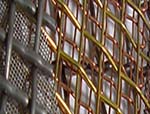
| Wires are woven together to
create wire mesh or called wire mesh in different weave patterns, such as plain
weave and twilled weave. The most common materials used to create woven wire
cloth are metallic including carbon steel, pre-galvanized steel, aluminum,
copper/brass/bronze and stainless steel. Other materials such as Monel,
Hastelloy, Inconel, Titanium or other nickel alloys can also be woven into wire
mesh. The common finish option can be galvanizing, chrome plating, copper
plating, PVC dipping and powder coating in different colors. Carbon steel woven
wire cloth is available upto 100 mesh. |
Wire cloth or wires can be
sintered together into Sintered Laminates or Sintered Felt. Space Screen and Square
Mesh in 10 mesh and coarser are typically woven from pre-crimped wires. Such
material remains stable and rigid after the crimping process. Wire cloth woven
from pre-crimped wires provides accurate openings and is woven tighter than
plain weave. Pre-crimped weaves are preferred for vibrating screens, decoration
and many other applications where sizing is critical. I.
CRIMPED STYLES Our pre-crimped woven wire
cloth is available in double weave, inter-crimp, lock-crimp, double lock-crimp,
triple shoot and flat top woven styles, and they are ideal for architectural
applications. |
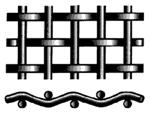 | 1. Double Crimp: The most common type. Also
referred to as "Over and Under" this weave is commonly used for screening
operations in smaller openings in comparison to the wire diameter. Used for
medium to heavy wire in relation to screen opening size. |
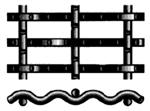 | 2. Inter Crimp: Used in coarse weaves of lighter
gauge wire to provide greater stability, tightness of weave and maximum
rigidity. Very common in mesh openings larger than 1/2"
(12.7mm). |
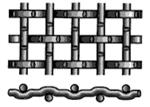 | 3. Lock Crimp: Also known as Scalping Weave.
Due to the deep crimps which lock the wires in place. It is used only in coarse
specifications to maintain the accuracy of weave throughout screen life, where
the opening is large with respect to wire diameter. |
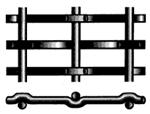 | 4. Double Lock
Crimp: Single shoot oblong openings
solve minor blinding problems for better flow. |
 | 5. Triple Shoot: Long openings will keep sticky
or wet material flowing freely. Weave holds wires securely yet permits slight
vibration to keep openings clear. |
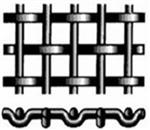 | 6. Flat Top: It usually starts at 5/8"
opening or larger providing long abrasive resistant life, since there are no
projections on top to wear and also offers least resistance to flow. It improves
material flow with a much smoother, flatter surface than other weaves, and
maintains accurate openings, and is very popular in certain architectural and
structural applications where a smooth surface on one side is
desirable. |
II. WEAVE
PATTERNS |
 | 1. Plain Weave: The most common weave, with the
same diameter warp and weft wires woven in a simple over and under pattern. It
produces screens with the same mesh count in both directions in square openings.
Sometime the opening is in Rectangular or called Off-Count" weave. Warp and weft
wire diameters are generally the same. |
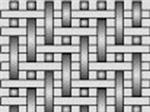 | 2. Twill Square: Each weft wire alternately
passes over two, then under two successive warp wires and each warp wire passes
alternately over two and under two successive weft wires, in a staggered
arrangement. Twill weave can be made from larger-diameter wires than would be
possible in plain square weave to obtain greater strength, density or corrosion
resistance. Twill weave is normally used to allow a heavier than standard wire
diameter in association with a given mesh. |
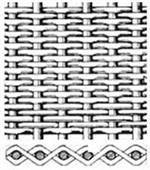 | 3. Plain Dutch
Weave: Also known as Plain Dutch
(Hollander) weave, woven in a plain, over and under pattern. While the warp
wires remain straight, the weft wires are plain woven to lie as close as
possible against each other in a linen weave forming a dense strong material
with small, irregular and twisting passageways that appear triangular when
diagonally viewing the weave. A thinner, smaller diameter weft wire is used;
these are driven very close together creating a very tight weave. Dutch weaves do not have a
straight-through, clear opening as do most plain weave styles. Instead the weave
style creates a tortuous path through which very fine filtration and particle
retention can be achieved. Dutch weaves may be specified by "mesh count" or
"absolute filter rating." |
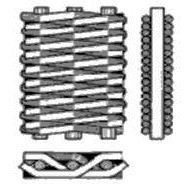 | 4. Dutch Twill
Weave Similar to Plain Dutch except
woven in the Twill style with a double layer of weft wires. Each wire passes
over two wires then under two wires, still utilizing a smaller-diameter weft
wire, allowing an even tighter weave and even finer filtration than Plain Dutch
weave. There are no apertures in the true sense of the word as the filtrate
follows a sinuous path through the depth of the wire cloth. |
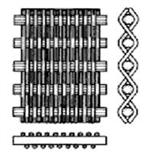 | 5. Reverse Dutch
Weave The same weave as Plain Dutch
except the warp and weft wires are reversed; I.E., the warp wires have a smaller
diameter than the weft wires. The larger weft wires are woven closer together
than would usually be seen in a Plain Dutch
weave. |